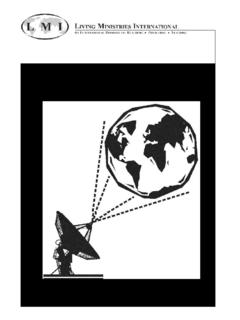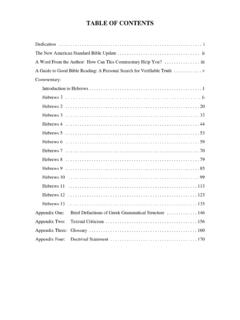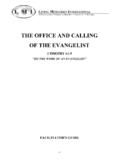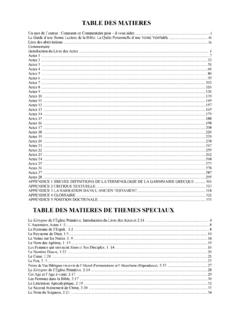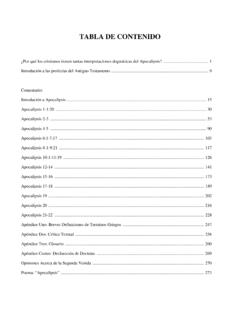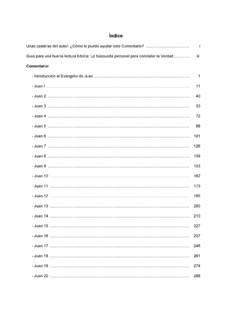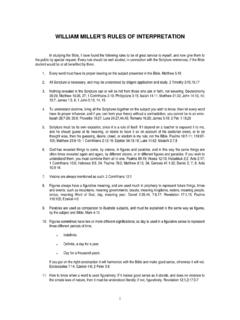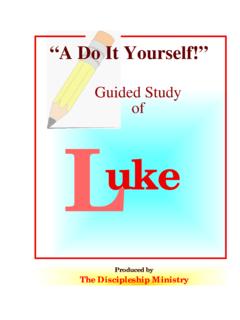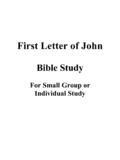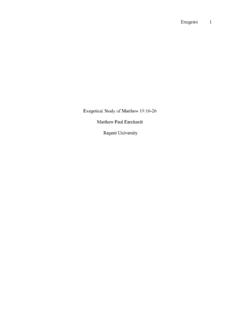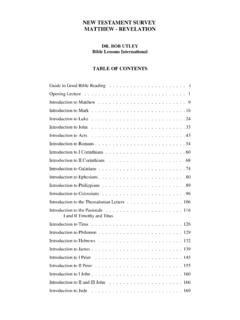Transcription of Luke the Historian: The Gospel of Luke
1 YOU CAN UNDERSTAND THE BIBLE! luke the Historian: The Gospel of LukeBOB UTLEYPROFESSOR OF HERMENEUTICS(BIBLICAL interpretation ) study GUIDE COMMENTARY SERIESNEW TESTAMENT, VOL. 3 ABIBLE LESSONS INTERNATIONAL, MARSHALL, TEXAS2004 (REVISED 2011) TABLE OF CONTENTSA Word From the Author: How Can This Commentary Help You? .. iGuide to Good Bible Reading: A Personal Search for Verifiable iiiAbbreviations Used in This Commentary .. ixCommentaryIntroduction to luke .. 1 luke 1 .. 6 luke 2 .. 42 luke 3 .. 62 luke 4 .. 77 luke 5 .. 97 luke 6 .. 109 luke 7 .. 127 luke 8 .. 136 luke 9 .. 152 luke 10 .. 172 luke 11 .. 187 luke 12 .. 204 luke 13.
2 222 luke 14 .. 230 luke 15 .. 236 luke 16 .. 244 luke 17 .. 257 luke 18 .. 266 luke 19 .. 277 luke 20 .. 287 luke 21 .. 301 luke 22 .. 311 luke 23 .. 330 luke 24 .. 342 Appendix One:Brief Definitions of Greek Grammatical 354 Appendix Two: Textual Criticism .. 361 Appendix Three: Glossary .. 364 Appendix Four: Doctrinal Statement ..371 SPECIAL TOPIC TABLE OF CONTENTSArch , 1:2 .. 9 Hebrew and Greek Background of Logos, 1:2 .. 10 Righteousness, 1:6 .. 12 Cherubim, 1 16 Son of God, 1:33 .. 20 Forever (Greek Idiom), 1:33 .. 21 Holy, 1 22 Believe, Trust, Faith and Faithfulness in the OT, 1 23 Believe, 1:45.
3 26 Anthropomorphic Language used for God, 1 28 The Heart, 1:51 .. 29 New Testament Prophecy, 1:67 .. 31 Names for Deity, 1:68 .. 33 Ransom/Redeem, 1:68 .. 35 Covenant, 1:72 .. 37Be Made Strong, 1:80 .. 40 Spirit (pneuma) in the NT, 1:80 .. 40 Firstborn, 2:7 .. 44 Glory, 2:9 .. 45 Bob s Evangelical Biases, 2:10 .. 46 Anointing In the Bible, 2:11 .. 47 Messiah, 2:11 .. 47 Election/Predestination and the Need for a Theological Balance, 2:14 .. 49 Comfort, 2:25 .. 53 Inspiration, 2:25 .. 53 Women in the Bible, 2:36 .. 55 Paul s Use of Women in Ministry, 2:36 .. 57 Gnosticism, 2 58 Pontius Pilate, 3 63 The Family of Herod the Great, 3:1.
4 64 Repentance, 3:3 .. 66 Forgiveness in the OT, 3:3 .. 66OT Titles of the Special Coming One, 3 69 Fire, 3:16 .. 70 Where Are the Dead?, 3:17 .. 71 The Trinity, 3:22 .. 73 Spirit in the Bible, 4:1 .. 79 The Demonic in the OT, 4 81 Greek Verb Tenses for Testing and Their Connotations, 4:2 .. 82 Satan, 4:2 .. 82 Synagogue Service, 4:16 .. 87 The Kingdom of God, 4:21 .. 88 Amen, 4:24 .. 89 The Demonic (Unclean Spirit), 4:33 .. 91 Jesus the Nazarene, 4 92 The Holy One, 4:34 .. 93 Laying On of Hands, 4:40 .. 95 Pharisees, 5:17 .. 101 Jesus and The Spirit, 5:17 .. 102 Scribes, 5 103Is Healing God s Plan for Every Age?, 5 104 Son of Man, 5:24.
5 105 Chart of the Apostles Names, 5:27 .. 105 Fasting, 5:33 .. 108 Sabbath, 6:1 .. 111 The Number Twelve, 6:13 .. 114 Peter, The Man, 6:14 .. 115 Should Christians Judge One Another?, 6 121 Hypocrites, 6:42 .. 123 Human Speech, 6 123 Apostasy, 6:46 .. 124 Nazarite Vow, 7 133 The Women Who Followed Jesus, 8:3 .. 141 Mystery in the NT, 8:10 .. 143 The Need to Persevere, 8:13 .. 145 This Age and the Age to Come, 9:2 .. 155 The Sanhedrin, 9:22 .. 158 The Resurrection, 9:22 .. 160NT Terms for Christ s Return, 9:26 .. 161 The Second Coming, 9:26 .. 162 Servant Leadership. 9 166 The Name of the Lord, 9:48 .. 166 Send, 9 167 Eastern Literature, 9:50.
6 168 Ascension, 9:51 .. 169 Symbolic Numbers in Scripture, 10:1 .. 174 Degrees of Rewards and Punishment, 10:12 .. 177 Grieving Rites, 10:13 .. 179 The Greatest Commandment, 10:27 .. 183 Sanctification, 11 190 The Unpardonable Sin, 11 193 Generous/Sincere, 11:34 .. 197 Terms for Foolish People, 11:40 .. 198 Almsgiving, 11:41 .. 199 Tithing, 11:42 .. 200 Monotheism, 12 207 Confession, 12 208 Personhood of the Spirit, 12 210 Wealth, 12:21 .. 211 Cubit, 12:25 .. 214 The Any-Moment Return of Jesus Versus the Not Yet (NT Paradox), 12:39 .. 217NT Terms for Christ s Return, 12:40 .. 218 The Remnant, Three Senses, 13:23 .. 226 Shadow As A Metaphor for Protection and Care, 13 228 Coins in Use in Palestine in Jesus Day, 15 239 ANE Weights and Volumes, 16:6.
7 247 The Divisions of the Hebrew Bible, 16:16 .. 251 Repentance in the OT, 17:4 .. 259 Election, 18:7 .. 268 Destruction, 19:10 .. 280 Authority (Exousia), 20 289 Cornerstone, 20:17 .. 292 Sadducees, 20 294 the sons of God in Genesis 6, 20:36 .. 296 Coming On the Clouds, 21:27 .. 307 Soon Return, 21 308 That Day, 21:34 .. 309 Iscariot, 22 314 Order of Passover Service in First Century Judaism, 22:17 .. 316 Biblical Attitudes Toward Alcohol and Alcoholism, 22 317 Poured Out, 22:20 .. 319 The Lord s Supper in John 6, 22:20 .. 319 Servant Leadership, 22 320 The Women Who Traveled with Jesus and His Disciples, 22 321 Reigning in the Kingdom of God, 22:30.
8 322 Father, 22:42 .. 325 Illegalities of the Sanhedrin s Night Trial, 22 328 Burial Practices, 23:53 .. 340 Burial Spices, 24:1 .. 344 The Kerygma of the Early Church, 24 348 Jesus Post Resurrection Appearances, 24:34 .. 349iA WORD FROM THE AUTHOR: HOW CAN THIS COMMENTARY HELP YOU?Biblical interpretation is a rational and spiritual process that attempts to understand an ancient inspired writer in such a waythat the message from God may be understood and applied in our spiritual process is crucial but difficult to define. It does involve a yieldedness and openness to God. There must bea hunger (1) for Him, (2) to know Him, and (3) to serve Him.
9 This process involves prayer, confession and the willingness forlifestyle change. The Spirit is crucial in the interpretive process, but why sincere, godly Christians understand the Bibledifferently, is a rational process is easier to describe. We must be consistent and fair to the text and not be influenced by our personalor denominational biases. We are all historically conditioned. None of us are objective, neutral interpreters. This commentaryoffers a careful rational process containing three interpretive principles structured to help us overcome our PrincipleThe first principle is to note the historical setting in which a biblical book was written and the particular historical occasionfor its authorship.
10 The original author had a purpose, a message to communicate. The text cannot mean something to us that itnever meant to the original, ancient, inspired author. His intent not our historical, emotional, cultural, personal ordenominational need is the key. Application is an integral partner to interpretation , but proper interpretation must alwaysprecede application. It must be reiterated that every biblical text has one and only one meaning. This meaning is what the originalbiblical author intended through the Spirit's leadership to communicate to his day. This one meaning may have many possibleapplications to different cultures and situations.

